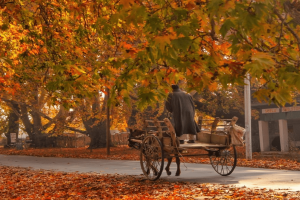
Harissa: The perfect winter dish to beat the cold in Kashmir
Harissa: A Hearty Kashmiri Delight to Warm Your Soul
Kashmir, known for its picturesque landscapes and rich cultural heritage, offers not just scenic beauty but also a culinary treasure chest. Among its many culinary delights, one dish stands out, especially during the winter months, as the perfect comfort food to ward off the cold – Harissa. This hearty and flavorful stew, made from mutton, rice, and spices, has a rich history that dates back centuries. In this article, we’ll delve into the origins of Harissa, how it’s traditionally prepared, and its cultural significance. Plus, we’ll share a simple recipe to bring this Kashmiri classic to your kitchen.
A Taste of History – The Persian Influence
The history of Harissa in Kashmir is steeped in cultural exchanges. It’s believed that Harissa was introduced to the region by Persian immigrants during the Mughal era. This flavorful dish quickly found its way into the hearts and kitchens of Kashmiri people. Today, it’s a beloved staple and one of the most cherished dishes in the region.
The Art of Making Harissa – Ingredients and Variations
Harissa is traditionally made with mutton, although chicken or beef can be substituted. The meat is simmered until it’s tender and then meticulously shredded. The rice, a key component, is soaked for several hours before joining the pot. To infuse the stew with its signature taste, a blend of spices including fennel seeds, cardamom, and cloves is added.
Also Read | Walnuts and Kashmir
Slow Cooking Tradition
One of the hallmarks of Harissa’s preparation is the slow-cooking tradition. Traditionally, it’s cooked overnight in a clay pot over a wood fire. This unhurried process allows the flavors to meld, and the meat to attain a melt-in-your-mouth tenderness. However, modern adaptations have seen Harissa prepared in pressure cookers or on stovetops, reducing the cooking time while still preserving its essence.
A Wholesome Meal – The Perfect Accompaniments
Harissa is best enjoyed with a hot Kashmiri bread called “tchot.” The stew is generously ladled onto the bread and then garnished with finely chopped onions, fresh cilantro, and a drizzle of pungent mustard oil. This combination not only adds a medley of textures and flavors but also complements the hearty nature of the dish.
Harissa’s Nutritional Profile – Health Benefits
Beyond its delightful taste, Harissa boasts a rich nutritional profile. It’s an excellent source of protein, carbohydrates, and essential vitamins. Moreover, it’s believed to offer several health benefits, such as:
- Boosting Immunity: Harissa’s spices, including turmeric, are known for their potential immune-boosting properties.
- Improving Digestion: Some of the spices used in Harissa, like fennel seeds, can aid in digestion and alleviate gastrointestinal discomfort.
Also Read | Namda: A traditional craft from Kashmir finds new life in the global market
Cooking Up Harissa at Home
Recipe for a Simple Harissa
Ingredients:
- 1 kg mutton, cut into pieces
- 1 cup rice
- 1 onion, chopped
- 1 teaspoon fennel seeds
- 1/2 teaspoon cardamom seeds
- 1/4 teaspoon cloves
- 1/2 teaspoon turmeric powder
- 1/2 teaspoon red chili powder
- 1/4 teaspoon salt
- 1/4 cup mustard oil
Instructions:
- Rinse the rice and soak it in water for at least 2 hours.
- Heat the mustard oil in a large pot. Add the chopped onions and cook until softened.
- Add the mutton and cook until it’s browned on all sides.
- Incorporate the soaked rice, fennel seeds, cardamom seeds, cloves, turmeric powder, red chili powder, and salt. Stir everything together.
- Add enough water to cover the ingredients by about 2 inches.
- Bring the stew to a boil, then reduce the heat to low and simmer for 2-3 hours, or until the mutton is tender, and the rice is cooked through.
- Serve piping hot with tchot bread and your favorite toppings.
Tips for the Perfect Harissa
- Use high-quality mutton with a good amount of fat for the best flavor.
- Soak the rice for at least 2 hours to ensure even cooking.
- Avoid overcrowding the pot to allow the meat to brown properly.
- Experiment with a variety of spices to give your Harissa a unique twist.
- Patience is key – slow-cook your Harissa for the most tender and flavorful results.
Beyond Bread: Harissa’s Accompaniments
While tchot bread is the traditional accompaniment for Harissa, you can also enjoy this delicious stew with:
- Salad: A simple green salad provides a refreshing contrast to the rich flavors of Harissa.
- Naan: If you don’t have tchot bread, naan, another type of Indian bread, pairs wonderfully with Harissa.
- Raita: A yogurt-based condiment like raita can cool down your palate after savoring the spicy flavors of Harissa.
Also Read | Kashmir: The Rising Star of Destination Weddings
Bottom-Line : Harissa is not just a dish; it’s a cultural icon that encapsulates the essence of Kashmiri cuisine. With its rich history, deep flavors, and heartwarming traditions, Harissa has rightfully earned its place as a beloved treasure in Kashmir. Its ability to bring warmth to the coldest of winter days and nourishment to the soul makes it a dish worth savoring. Whether enjoyed in the heart of Kashmir or recreated in your own kitchen, Harissa is a culinary delight that transcends borders and brings people together in the spirit of good food and cherished traditions.
Article contributed by KashmirStore.in and KashmirBazar.in, your trusted vendors for authentic Kashmiri products.

